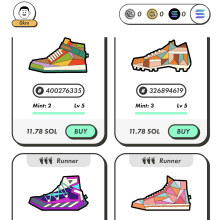“In August last year we were really bored. We were half retired and had nothing to do. I’d hand-balled my business to fund managers, and I was just making Lego in the house,” Mr Rong said.
“We started this project as something meaningful to do. We wanted to build a mini-game, running on the blockchain, to fight against climate change.
“We donate a portion of our profits to buy carbon removal credits, and we also get people healthier. We were still in lockdown at the time, and we wanted to get people outdoors and exercising.”
How it works
The game became so popular so quickly while it was still in beta mode that to moderate the influx of users, the company is now releasing only 2000 access codes each day, via Telegram and Discord. This has helped maintain hype around the game, but has also bought the founders time to continue building the app’s infrastructure, while early users try it out.
Once users have an access code and have signed up, they must buy and transfer Solana’s native cryptocurrency, SOL, to their StepN wallet, which can then be used to purchase their first pair of digital sneakers.

StepN’s digital sneaker marketplace.
The catch? The sneakers cost upwards of 12 SOL each, equivalent to about $985. Last week it would have cost $1200, but SOL was sold off alongside all other cryptocurrencies. The most expensive sneakers cost the equivalent of $820,000.
“We targeted the well-off population who can spend thousands on virtual sneakers, and people who care about their mental and physical health, as well as climate change,” Mr Rong said.
“Those people are traditionally difficult to target, but with tokenomics, they’re helping us spread the word.
“I studied molecular biology at university, and this is just like how a virus spreads.”
A note from Delphi Digital earlier this month stated that the SOL trading volumes from StepN were so high that it had already become the dominant force within the Solana NFT ecosystem, with volumes hitting as high as $US57 million ($82.8 million) per day. This volume results in revenue for StepN, which charges a 6 per cent fee (2 per cent trading fee, and a 4 per cent royalty fee) on every transaction in its app.
Each pair of sneakers comes with traits – rarity, stats and energy, which influence a wearer’s earning (token generation) power.
Each energy point enables users to earn rewards for five minutes of workout time, and 25 per cent of energy is replenished every six hours. The app tracks a user’s steps, moved and GPS location to prevent cheating.
The company, Mr Rong said, also has partnerships in the works with Nike and Adidas to launch NFT sneakers.
While the app has been an instant hit with user’s, investors have been sent on a wild ride thanks to the volatility of the price of its tokens.
The start-up has two tokens – its Green Satoshi utility token (GST), which has an unlimited supply, and the Green Metaverse Token (GMT), its governance token. In early March StepN GMT was priced at only US1¢, but in late April, it hit a high of more than $US4, before tumbling back to around $US1.57. It slid as low as US82¢ in last week’s crash.
Before the sell-off, early investors were raving about how the returns were outstripping that of tech unicorn Canva. While the volatility has taken a sledgehammer to these returns, the tokens are still worth many hundreds of times more than what early investors bought them for.
Mr Rong said the sell-off had not affected StepN.
“As the crypto market liquidated over $1 trillion in three days, our user growth was not affected at all. It is certainly good to see the bubble squeezed and always when that happens, the true opportunity emerges.
“STEPN came out during the bear market and we have been fighting this upwind battle since day one, so I actually felt nothing.”
Early investors are all subject to escrow agreements, in which they cannot sell any tokens for at least 12 months.
Mr Shi, who also invested in Catapult Sports, Airtasker and Sezzle before they listed, said he had been a significant investor in the company’s $5 million raise. He says he assesses crypto opportunities like StepN the same way he does any start-up investment.
“I pass as a traditional VC, and also a Web3 and crypto investor,” he said.
“I know the team. I almost decided to invest after the first meeting with one of the founders, Jerry, who has a very good, solid background.
“I look at people’s stories, where they come from and how desperate they are to be successful.”




